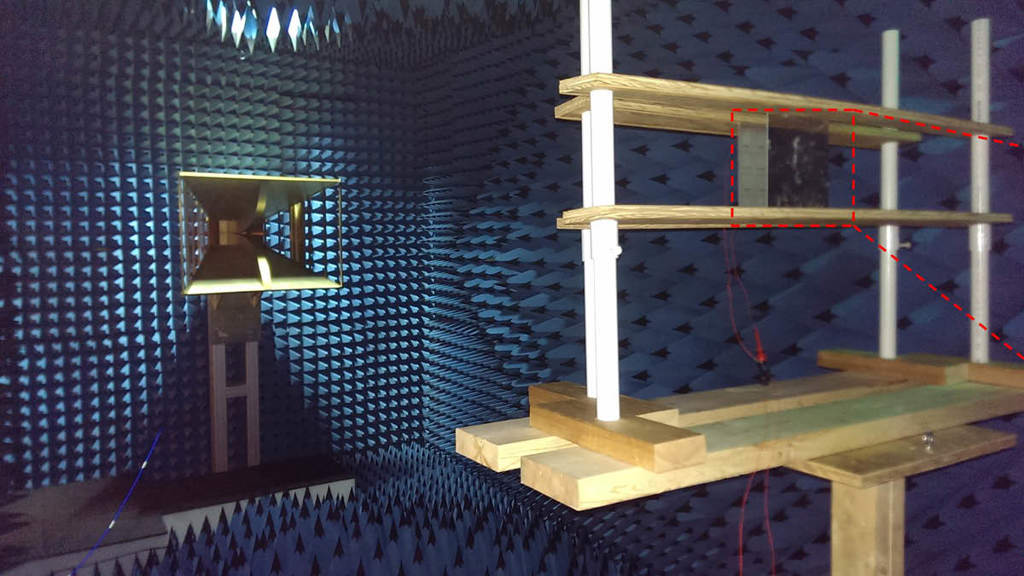Metasurface-based antenna turns ambient radio waves into electric power
About Optica
28 February 2022
Metasurface-based antenna turns ambient radio waves into electric power
Technology could make it possible to use radio emissions from cell phone networks to wirelessly power sensors and LEDs
WASHINGTON — Researchers have developed a new metasurface-based antenna that represents an important step toward making it practical to harvest energy from radio waves, such as the ones used in cell phone networks or Bluetooth connections. This technology could potentially provide wireless power to sensors, LEDs and other simple devices with low energy requirements.
“By eliminating wired connections and batteries, these antennas could help reduce costs, improve reliability and make some electrical systems more efficient,” said research team leader Jiangfeng Zhou from the University of South Florida. “This would be useful for powering smart home sensors such as those used for temperature, lighting and motion or sensors used to monitor the structure of buildings or bridges, where replacing a battery might be difficult or impossible.”
In the journal Optical Materials Express, the researchers report that lab tests of their new antenna showed that it can harvest 100 microwatts of power, enough to power simple devices, from low power radio waves. This was possible because the metamaterial used to make the antenna exhibits perfect absorption of radio waves and was designed to work with low intensities.

Caption: The researchers tested their metamaterial-based antenna in an anechoic chamber. The radio wave is sent out from the horn antenna on the left and received by the metasurface antenna mounted on the wood frame on the right. The anechoic chamber eliminates background signals from other sources and prevents stray signals from the radio wave source from bouncing around the room and perturbing measurements. The image of metamaterial-based antenna is enlarged on the right.
Image Credit: Jiangfeng Zhou and Clayton Fowler
“Although more work is needed to miniaturize the antenna, our device crosses a key threshold of 100 microwatts of harvested power with high efficiency using ambient power levels found in the real world,” said Clayton Fowler, the team member who fabricated the sample and performed the measurements. “The technology could also be adapted so that a radio wave source could be provided to power or charge devices around a room.”
Harvesting energy from the air
Scientists have been trying to capture energy from radio waves for quite some time, but it has been difficult to obtain enough energy to be useful. This is changing thanks to the development of metamaterials and the ever-growing number of ambient sources of radio frequency energy available, such as cell phone networks, Wi-Fi, GPS and Bluetooth signals.
“With the huge explosion in radio wave-based technologies, there will be a lot of waste electromagnetic emissions that could be collected,” said Zhou. “This, combined with advancements in metamaterials, has created a ripe environment for new devices and applications that could benefit from collecting this waste energy and putting it to use.”
Metamaterials use small, carefully designed structures to interact with light and radio waves in ways that naturally occurring materials do not. To make the energy-harvesting antenna, the researchers used a metamaterial designed for high absorption of radio waves and that allows a higher voltage to flow across the device’s diode. This improved its efficiency at turning radio waves into power, particularly at low intensity.
Testing with ambient power levels
For lab tests of the device, which measured 16 cm by 16 cm, the researchers measured the amount of power harvested while changing the power and frequency of a radio source between 0.7 and 2.0 GHz. They demonstrated the ability to harvest 100 microwatts of power from radio waves with an intensity of just 0.4 microwatts per centimeter squared, approximately the level of intensity of the radio waves 100 meters from a cell phone tower.
“We also placed a cell phone very close to the antenna during a phone call, and it captured enough energy to power an LED during the call,” said Zhou. “Although it would be more practical to harvest energy from cell phone towers, this demonstrated the power capturing abilities of the antenna.”
Because the current version of the antenna is much larger than most of the devices it would potentially power, the researchers are working to make it smaller. They would also like to make a version that could collect energy from multiple types of radio waves simultaneously so that more energy could be gathered.
Paper: C. Fowler, S. Silva, G. Thapa, J. Zhou, “High Efficiency Ambient RF Energy Harvesting by a Metamaterial Perfect Absorber,” Opt. Mater. Express Vol. 12, Issue 3, pp. 1242-1250 (2022) https://doi.org/10.1364/OME.449494
Approved for Public Release by the MITRE Corporation; Distribution Unlimited. Public Release Case Number 22-0521
Clayton Fowler is currently with The MITRE Corporation. The author's affiliation with The MITRE Corporation is provided for identification purposes only and is not intended to convey or imply MITRE's concurrence with, or support for, the positions, opinions, or viewpoints expressed by the author.
About Optica Publishing Group
Optica Publishing Group is a division of the society, Optica, Advancing Optics and Photonics Worldwide. It publishes the largest collection of peer-reviewed and most-cited content in optics and photonics, including 18 prestigious journals, the society’s flagship member magazine, and papers and videos from more than 835 conferences. With over 400,000 journal articles, conference papers and videos to search, discover and access, our publications portfolio represents the full range of research in the field from around the globe.
About Optical Materials Express
Optical Materials Express is an open-access journal focusing on the synthesis, processing and characterization of materials for applications in optics and photonics. It is published by Optica Publishing Group and emphasizes advances in novel optical materials, their properties, modeling, synthesis and fabrication techniques; how such materials contribute to novel optical behavior; and how they enable new or improved optical devices. The Editor-in-Chief is Andrea Alù from City University of New York, USA. For more information, visit Optical Materials Express.
Media Contact
